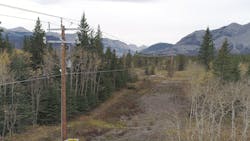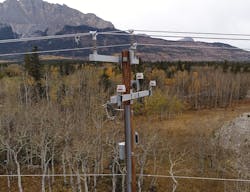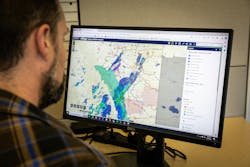With the Rocky Mountains on its western border and prairies to the east, the Canadian province of Alberta boasts a wide variety of natural landscapes. An abundance of forested locations and prairie grasslands in FortisAlberta Inc.’s service area means managing wildfire risk has always been a critical part of this pure-play distribution utility’s operations. As owner and operator of approximately 60% of Alberta’s electric distribution system, FortisAlberta serves almost 600,000 customer sites of various kinds and continues a decades-long tradition of providing safe and reliable service to Albertans living outside of the province’s two major centers, Calgary and Edmonton.
FortisAlberta’s approach to mitigating the risk of ignition events on its more than 1.1 million poles and 129,000 km (80,157 miles) of conductor combines the use of time-proven traditional practices, like detailed line patrols and effective vegetation management, with the thoughtful and targeted deployment of innovative technologies. The utility takes a 360-degree approach to managing wildfires and their operational consequences for customers by supplementing mitigation practices aimed at decreasing the likelihood of ignition events with resilience investments that can mitigate wildfire-related restoration timelines and costs.
These strategies, combined with FortisAlberta’s award-winning operational approach to coordinating response and restoration efforts with local authorities when incidents occur, positions the utility to continue to provide effective and cost-efficient holistic wildfire mitigation for the benefit of its customers.
Right-Sizing Strategy
FortisAlberta has always taken a practical and multifaceted approach to wildfire risk mitigation. In Alberta, the government has designated certain wooded areas as being part of the province’s Forest Protection Area (FPA). The utility is required to implement a wildfire control plan to support its operations in the FPA, and it has leveraged its experience in this regard to support the development of a wider wildfire risk mitigation strategy.
Key components of FortisAlberta’s strategy include using situational awareness tools to quickly adjust its operations as weather conditions evolve; fine-tuning asset and vegetation management programs in high-risk fire areas (HRFA); and leveraging engineering standards and technologies to enhance overall mitigation of ignition risks and create a resilient system.
In preparation for establishing a wildfire control plan, FortisAlberta retained a third-party consultant to complete analyses that would allow the utility to better understand the impact of wildfire on land-based infrastructure near its power lines using different mapping techniques. The consultant first developed a map that identified HRFAs in the utility’s service area based on an assessment of various factors, such as prevailing climate conditions and proximity to fuel sources, to enable FortisAlberta to understand locational differences in these variables.
Next, the consultant developed ignition-point risk maps for locations where the utility’s infrastructure is located. These maps integrate critical metrics that indicate potential fire intensity and impact in a specific area. Measuring the intensity of simulated fires and their consequences enables the utility to assess the potential overall severity of wildfire impacts at various locations.
In parallel, the utility developed its own wildfire-specific electronic map (eMap) solution that overlays information from a variety of sources — including weather alerts from Environment Canada, satellite detection of thermal hot spots, ongoing fire activities such as local fire bans, advisories and active fires, and information from the Canadian Wildland Fire Information System (CWFIS) fire danger index — to provide near-real-time information to FortisAlberta’s control center regarding current ignition risks.
These digital mapping tools are vital observational and analytical resources that enable continuous monitoring of environmental changes, including variations in moisture levels, wind conditions and local weather phenomena. Such innovative surveillance approaches aid in detecting changes in operational conditions, thereby enabling informed decision-making in wildfire management and mitigation efforts.
A key advantage of the utility’s eMaps-based approach is it enables control center operators to use both installed technology and workforce management approaches to reduce the overall risk of an ignition event. For example, the remote disabling of reclosing technology in areas identified by the eMaps as presenting a risk can prevent potential fire ignition from fallen tree branches contacting conductors. Operationally, routine construction and maintenance work can be stopped in areas flagged as high risk to prevent potential ignition from vehicles and tools. Additionally, field employees deployed to higher-risk areas are equipped and prepared to provide first response to wildfires by carrying water packs, fire brooms, axes and shovels to ensure work plans address fire safety and risk mitigation aspects.
Asset and Vegetation Management
FortisAlberta leverages wildfire risk assessment tools to strategically prioritize asset maintenance and repair activities. Power line technicians use the utility’s HRFA maps when conducting line patrols to help them precisely locate critical infrastructure components, including pole line hardware, conductors, porcelain switches and insulators at increased risk of failure and, consequently, targeted for priority repair or replacement.
The utility has refined its vegetation management program to align with industry best management practices around maintaining clearances and ensuring reliability of the distribution system. The goal of the utility’s program is to use integrated vegetation management (IVM) following stakeholder consultation and approval. This approach includes the removal of incompatible (that is, faster-growing or taller) vegetation from rights-of-way and allowing compatible vegetation (that is, lower-growing) vegetation to overtake these areas.
Standards and Technologies
FortisAlberta has piloted and, in some cases, adopted new practices and technologies to enhance the resilience and reliability of its distribution system against environmental challenges, including wildfire risks. Some of the technologies existing on the utility’s system serve a dual purpose of helping to maintain reliability and minimize restoration times, while also helping to mitigate wildfire risk. One example of this is FortisAlberta’s use of supervisory control and data acquisition (SCADA) equipment.
The utility has replaced hydraulic reclosers with SCADA-capable electronic reclosers and introduced non-expulsion-type fuses and cutout-mounted reclosers across its system. In HRFAs, FortisAlberta currently is evaluating the introduction of adaptive protection setting enhancements for SCADA devices. Using traditional protection settings, SCADA-enabled reclosers are configured with fixed parameters that do not change in response to the network’s operational state. However, using adaptive protection settings, the utility can adjust these parameters in real time or near real time to optimize local protection schemes according to current conditions on the electrical system.
Changing the reclosers’ trip settings, fault detection sensitivity and timing of the reclosing sequence in response to local conditions affecting wildfire risk can mitigate the risk of ignition events, by deenergizing discrete areas in response to phenomena that would not normally trigger a SCADA-supported response.
To guide engineering design and material selection for power line construction, FortisAlberta has developed region-specific wind maps to enhance resilience in high-wind zones in the province. The utility considers system reliability, resilience and safety to be closely related concepts.
In this regard, FortisAlberta has used its wind loading zone maps to support the development of engineering standards that reflect its system’s operating environment to ensure outage events (however they are caused), restoration times and any attendant rebuild costs are minimized.
The utility is exploring the integration of innovative wildfire resilience technologies, such as the application of fire-retardant coatings on wood poles and the adoption of alternative materials for structures located in water-crossing areas, to bolster its wildfire resilience measures and ensure required rebuilds are cost efficient.
Janine Sullivan, FortisAlberta’s president and CEO, says the utility’s approach to the deployment of innovative technology is thoughtful and cost conscious: “We embrace a ‘smart follower’ philosophy that uses the local piloting of proven technologies in areas of greatest benefit. It’s how we ensure that customers are receiving the best value from the related investments.”
Smart Follower In Action
Implementation of early fault detection equipment is the most recent and technologically advanced operational practice FortisAlberta has introduced, and it is already showing promising results through its ability to alert the utility to power line or transformers displaying signs of stress prior to failure. Developed in Australia by IND Technology Pty Ltd., early fault detection is deployed in several U.S. utilities.
After assessing the available options and conducting a pilot, FortisAlberta became the first in Canada to implement early fault detection devices. Ease of deployment and precision were key deciding factors. The technology can identify potential equipment failures, such as broken conductor strands, within a 10-m (33-ft) range, preventing full-fledged faults.
Within the first year of having the new technology on part of its system, FortisAlberta is seeing benefits with 17 actionable repairs identified to date, including broken strands, damaged conductor, foreign material interference and arcing contact. The utility installed sensors at 60 sites in 2022 and approximately 200 additional sites in 2023. It plans to add 300 more sites in 2024. The utility anticipates seeking further funding from its regulator to complete coverage in HRFAs.
When A Wildfire Does Happen
FortisAlberta will continue to regularly review its plans and introduce safeguards to help the system withstand fires when they happen. When the inevitable occurs, the utility focuses on restoring power quickly and cost effectively. In fact, it received the Edison Electric Institute’s Emergency Response Award for its wildfire response efforts in 2023.
In spring 2023, three major wildfires impacted FortisAlberta’s facilities within the northern part of its service territory, resulting in the stand-up of the utility’s emergency operations center (EOC) to manage the event. The EOC remained active for five weeks in May and June with fires impacting large portions of Brazeau and Yellowhead, two counties located within 200 km (124 miles) west of Edmonton, with the final estimated burn area totaling approximately 330,000 hectares (815,448 acres).
While no loss of life resulted from these wildfires, thousands of people were displaced, many of whom lost their homes and other property. Beginning as seven individual fires, the situation evolved quickly into three large, highly unpredictable fires compounded by crossover fire conditions, including wind, extreme heat and low humidity.
Looking back on this event and FortisAlberta’s response to it, Cam Aplin, the utility’s vice president of operations and customer experience, observed, “Even with all the complexities and challenges involved, we maintained a clean safety record throughout, with zero preventable injuries or vehicle incidents. This only makes us prouder of how quickly and effectively our employees were able to respond and restore power to our customers.”
Curtis Eck ([email protected]) has more than 30 years of engineering experience in the electricity industry. In his role as vice president, engineering, at FortisAlberta, Eck is responsible for providing leadership and direction to the utility’s engineering function He serves on the utility’s climate adaptation committee. He holds a master’s degree in engineering from the University of Colorado and is a registered Professional Engineer in Alberta, Canada.
By The Numbers
FortisAlberta Inc. had to contend with three major wildfires in the spring of 2023. Following is a look at key numbers from those wildfires. Keep in mind, the utility owns and operates electric distribution facilities, so damage to the transmission system and generation are not included in these numbers:
l Zero preventable injuries and reportable vehicle accidents
l Approximately 42 miles (68 km) of distribution line replaced
l Approximately 7000 total sustained outages at the peak of the event
l 835 distribution poles and 50 transformers replaced
l Approximately 16,000 employee hours, supplemented by contractors — without the need for mutual assistance from other utilities
About the Author
Curtis Eck
Curtis Eck ([email protected]) has more than 30 years of engineering experience in the electricity industry. In his role as vice president, engineering, at FortisAlberta, Eck is responsible for providing leadership and direction to the utility’s engineering function He serves on the utility’s climate adoption committee. He holds a master’s degree in engineering from the University of Colorado and is a registered Professional Engineer in Alberta, Canada.



